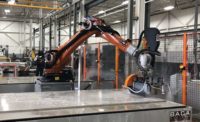Porcelain slabs are a growing part of the countertop market sector and the demand for fabricators to cut these materials is on the rise. But the number of fabricators that know how to deal with these materials is low. Stone World had the opportunity to talk to Nick Wadenstorer, owner of Total Stone Solutions, to discuss his strategy with cutting porcelain slabs.
SW: First, if you don’t mind, discuss the challenges of cutting porcelain.
NW: Porcelain cutting has brought one of the more difficult challenges of being in the stone industry. To most fabricators, this is a brand-new product that requires more sophisticated fabrication practices or you risk damaging the material in the manufacturing and installation process. Porcelain tends to be fragile and have tension in the material from baking and curing and creates a high risk of cracking and breakage during the cutting and polishing process.
SW: What are some tips you have for cutting porcelain?
NW: For blade cutting it is best to have a machine that can vary the RPM of the blade motor to increase that speed and put the proper thin rim blade with minimal flex. Most customers are using a smaller 14-inch blade with RPMs near 2,200 to 2,300.
Also, for a lot of customers, waterjets are preferred because it is a non-contact cut -- eliminating the vibration in the material during blade cutting which can cause it to crack.
For thin porcelain up to 6mm, customers can use a score and snap machine with success, but only for straight cuts.
SW: How important is tooling when cutting the material?
NW: As with cutting any material, using the proper blade is important. Most customers find that you should be using a porcelain specific blade that has additional core support and is thin without large gaps between segments. This minimizes the pounding on the material during cutting -- minimizing vibration and cracking.
SW: As far as handling it or installing it, what are the challenges?
NW: There are many handling devices dedicated to porcelain now, and I would highly recommend investing in those systems if you are going to be handling large panels of porcelain.







